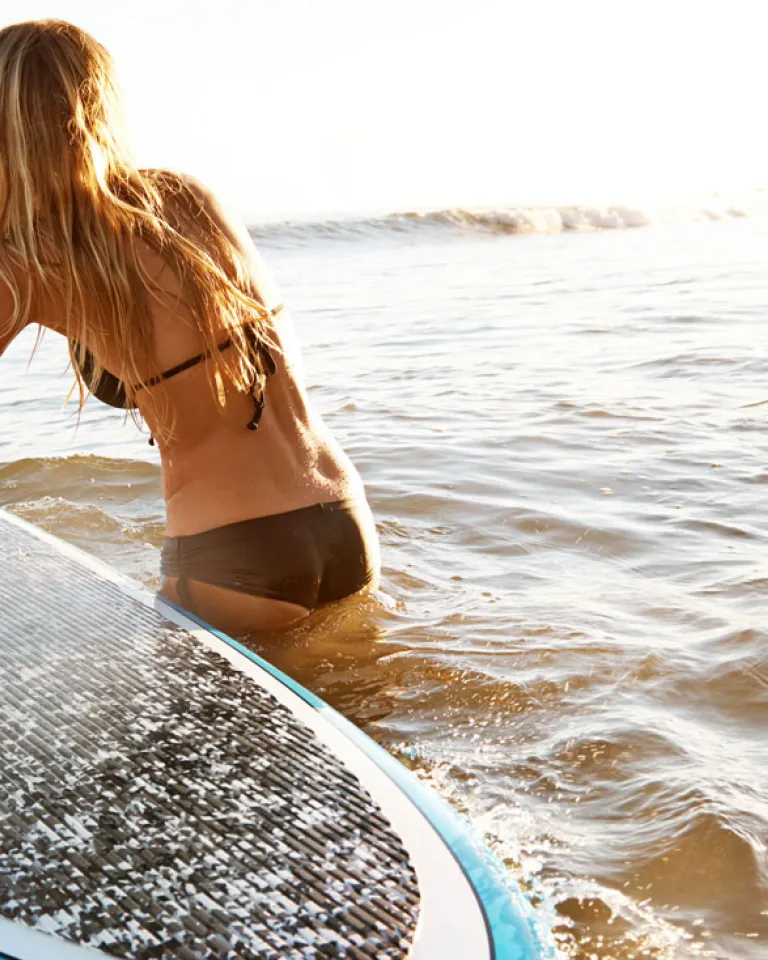Beginner's Guide to Stand up Paddle Boarding

Get The Gear
If you've never used an SUP, here's a quick guide to enjoying the water while getting a killer full-body workout. You'll need a few things to get started, namely an SUP, Paddle, PFD and most important, a body of water! You can SUP in a lake, a pond, rivers, bays and the open ocean. Your intended location is one of the most important considerations when choosing your stand up paddle board.
Stand up paddle board
This will be, by far, the most expensive item that comes in all shapes and sizes. Choosing the right board can seem like a daunting task. For beginners, the longer, wider and thicker boards are the best starting point. Wider, longer and thicker boards offer greater stability, ensuring beginners spend more time standing and less time falling. The downside is transport. The bigger boards are naturally heavier and unwieldy. Larger boards will almost always have a handle in the middle of the board for carrying, but again, if transporting more than a couple of block's worth of distance, this will be difficult and tiresome. There are many kinds of dollies or wheel transport systems out there for getting your SUP to and from the water. But if you're looking at SUPing as a workout activity, view the transport as part of the workout!
Paddle
When choosing a paddle, the type of water you're going to be in also weighs in heavy on your choice. For placid waters, longer paddles are preferred. For rougher waters or surfing conditions, you're going to want a shorter paddle for quicker maneuverability. In general, the paddle you choose should be 6-10 inches taller than you.
PFD (Personal Floatation Device)
The U.S. Coast Guard considers stand up paddle boards as vessels and thus require all people to have a PFD while paddleboarding. There are many types, make sure the one you choose is Coast Guard approved, usually Type II and III. Inflatable lifejackets are great for being light-weight and unobtrusive. Safety whistles are always a good idea and if you're paddleboarding during sunset, carry a light for when it's dark.
Leash
Most often sold separately, leashes ensure you don't lose your expensive board and also add a measure of safety as they tether you to your board which is a large floatation device. There are different types of leashes for different bodies of water; choose accordingly.
Attire
Remember, you're getting in the water, you will get wet so do not wear cotton clothing! The appropriate attire is water-wicking clothing or swimwear. If you're going to be in colder waters, wear a wetsuit. Long sleeved rash guards are great for keeping you cool and protected from the sun. And don't forget your sunscreen!
Get in the Water
Calm and flat waters are the best when you're just starting out. This will help you find your balance and get used to using your stabilizing muscles to keep you upright. Many find it easier to start off kneeling to get a better feel for how the board moves while in the water. The goal is to find the balance point of the board where the nose doesn't rise up and the tail doesn't dig in, or vice versa. To keep your balance utilize the following tips:
- Keep your feet parallel and centered on the board between the rails with a wide stance, hip-with or little wider
- Keep your upper body upright and straight, absorbing motion through your ankles, knees and hips. Keep your knees slightly bent
- Do not look at your feet, keep your gaze on the horizon to help keep your balance
- Get moving: forward momentum will increase your stability
Time to Paddle
The key to getting the most from your stroke is holding the paddle correctly and utilizing your core for power. Many beginners wear themselves out quickly by relying too much on their arms and aren't able to traverse very far. Proper technique will utilize your entire body, creating an efficient stroke that will propel you and your board smoothly. Here are some easy ways to ensure you get the most out of your stroke:
- It's not a broomstick, keep your top hand on the grip with your bottom hand about shoulder width or wider down the shaft.
- When paddling on the right, your top hand is your left hand.
- The bend of the elbow of the blade should mirror your own elbows, not your knees. This will seem counterintuitive for anyone who has paddled a canoe or kayak as it is the exact opposite but will ensure that the flat of the blade pushing the maximum amount of water at the proper angle.
- Completely submerge the blade and utilize your core and back muscles in your stroke. When the blade hits the water and you begin your pull, it starts from your feet. Your legs absorb the motion from the water and "push" your board forward while your arms act as a fulcrum to your torso as you pull yourself forward.
- To go straight, paddle a couple of times on each side before switching sides.
- Turning is the law of opposites: To turn right, you paddle on your left and lean your weight on the right rail.
- Remember to switch hands when switching the paddle to the other side.
Have Fun!
Remember above all else to have fun and enjoy your vantage point! Stand up paddle boarding is a great activity for sport, leisure or a workout. It's an investment to be sure, but if you have the time it is definitely worth it. And if you're not sure it's something that's going to be worth the initial investment, try it out first. There are plenty of places that rent stand up paddleboards and most rental companies cater to beginners with big, wide boards perfect for starting out. Once you try it, you're love it. So get in the water!
